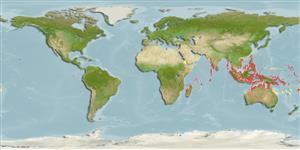Common names from other countries
>
Eupercaria/misc (Various families in series Eupercaria) >
Lethrinidae (Emperors or scavengers) > Lethrininae
Etymology: Lethrinus: Greek, lethrinia, a fish pertaining to genus Pagellus.
More on author: Valenciennes.
Environment: milieu / climate zone / depth range / distribution range
экология
морской ассоциированный с рифами; немигрирующий; пределы глубины 2 - 25 m (Ref. 9710). Tropical; 25°N - 25°S, 32°E - 173°W
Indo-West Pacific: Tanzania and Mozambique to Papua New Guinea, Palau, and Caroline Islands. Recently reported from the Penghu Islands (Ref. 55073).
Size / Вес / Возраст
Maturity: Lm ? range ? - ? cm
Max length : 50.0 cm TL самец/пол неопределен; (Ref. 2295); common length : 30.0 cm TL самец/пол неопределен; (Ref. 2295)
колючие лучи спинного плавника (общее число) : 10; членистые (мягкие) лучи спинного плавника (общее число) : 9; колючие лучи анального плавника: 3; членистые (мягкие) лучи анального плавника: 8. This species is distinguished by the following characters: body moderately deep, its depth 2.3-2.5 times in standard length; head length 0.8-1.0 times in body depth, 2.5-2.8 times in SL, dorsal profile near eye nearly straight or slightly convex; snout moderately short, its length about 1.9-2.2 times in head length, measured without the lip the snout is 0.9-1.0 times in cheek height, its dorsal profile concave, snout angle relative to upper jaw between 53° and 64°; interorbital space convex or almost flat; posterior nostril an oblong longitudinal opening, closer to orbit than anterior nostril; eye situated close to or slightly removed from dorsal profile, its length 3.3-4.6 times in HL; cheek moderately high, its height 2.1-2.7 times in HL; lateral teeth in jaws of adults molars or rounded; outer surface of maxilla usually smooth; D X,9, the 4th or 5th dorsal-fin spine the longest, its length 2.7-3.3 times in body depth; A III,8 with the 3rd, 4th or 5th soft ray usually the longest, its length much longer than length of base of soft-rayed portion of anal fin and 0.7-1 times in length of entire anal-fin base; pectoral-fin rays 13; pelvic-fin membranes between rays closest to body without dense melanophores; cheek without scales; 44-46 lateral-line scales; 4 ½ scale rows between lateral line and base of middle dorsal-fin spines; 15-17 scale rows in transverse series between origin of anal fin and lateral line; usually 15 rows in lower series of scales around caudal peduncle; 5-9 scales in supratemporal patch; inner surface of pectoral-fin base densely covered with scales; posterior angle of operculum fully scaly. Colour of head and body brown or rust red, lighter ventrally; sometimes 2 light bars on caudal peduncle; area around eye, a broad streak from eye to tip of snout, lips, and base of pectoral fins red; all fins reddish, often a bright red or orange (Ref. 114226).
Occurs over coral reefs and adjacent sandy areas. May be solitary or in small groups. Feeds on echinoderms, mollusks, crustaceans, and small fish. Caught mostly by handlines and traps. Marketed fresh. Also caught with handlines (Ref. 9775, 687103).
Life cycle and mating behavior
Maturities | размножение | Spawnings | Egg(s) | Fecundities | личинки
Carpenter, K.E. and G.R. Allen, 1989. FAO Species Catalogue. Vol. 9. Emperor fishes and large-eye breams of the world (family Lethrinidae). An annotated and illustrated catalogue of lethrinid species known to date. FAO Fish. Synop. 125(9):118 p. Rome: FAO. (Ref. 2295)
Статус Красного Списка МСОП (Ref. 130435)
CITES (Ref. 128078)
Not Evaluated
Угроза для людей
Harmless
Использование человеком
рыболовство: не имеет хозяйственного значения
дополнительная информация
инструменты
Специальные отчеты
Скачать в формате XML
ресурсы в Интернет
Estimates based on models
Preferred temperature (Ref.
115969): 27.4 - 29.3, mean 28.7 (based on 1949 cells).
Phylogenetic diversity index (Ref.
82804): PD
50 = 0.5000 [Uniqueness, from 0.5 = low to 2.0 = high].
Bayesian length-weight: a=0.01995 (0.01135 - 0.03508), b=3.09 (2.94 - 3.24), in cm Total Length, based on LWR estimates for this species & Genus-body shape (Ref.
93245).
Trophic level (Ref.
69278): 3.7 ±0.51 se; based on food items.
устойчивость к внешним воздействиям (Ref.
120179): средний (среднего размера), минимальное время удвоения популяции 1.4-4.4 года (Preliminary K or Fecundity.).
Fishing Vulnerability (Ref.
59153): Moderate vulnerability (40 of 100).
